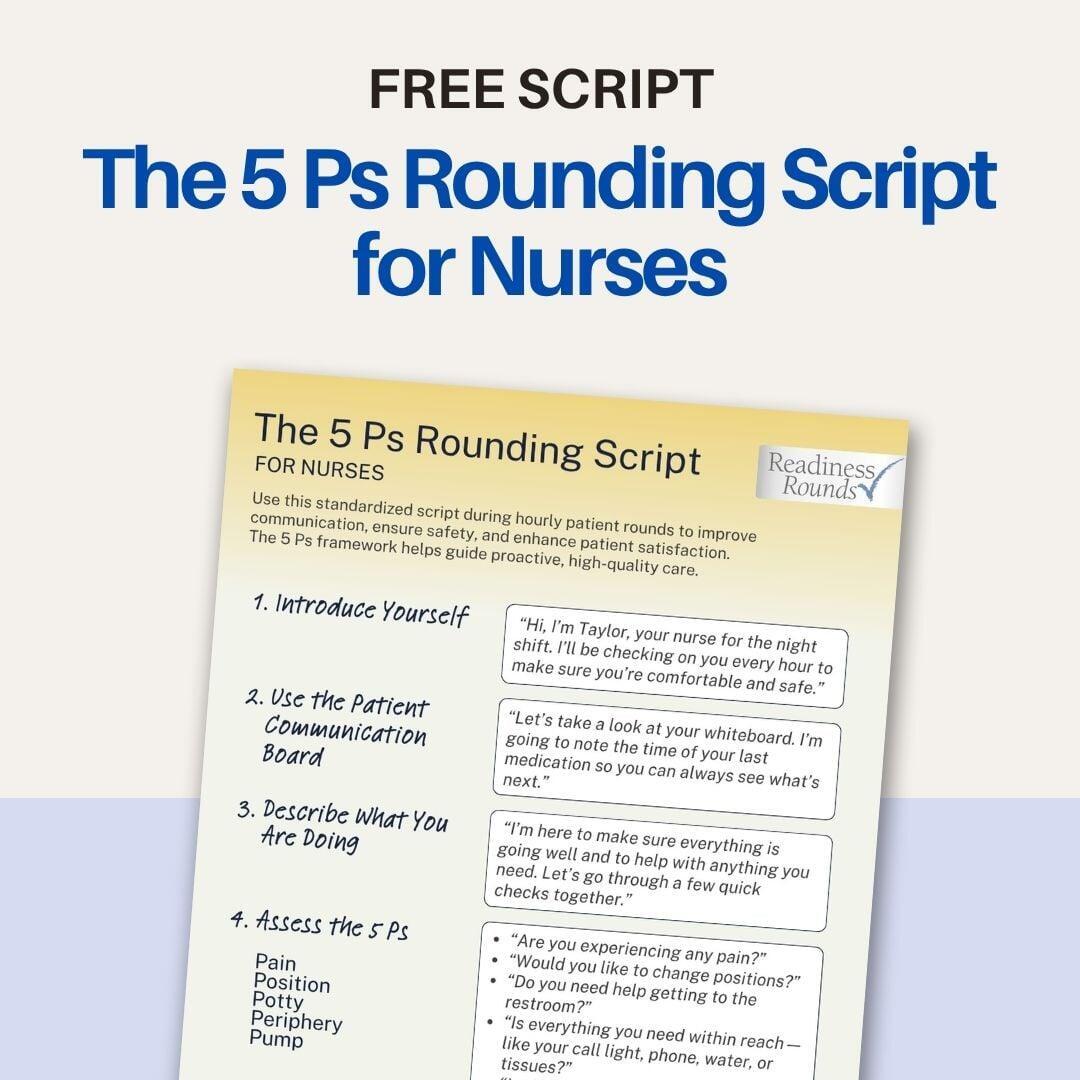
How the 5 Ps of Hourly Rounding Improve Patient Satisfaction & HCAHPS Scores
Patient satisfaction doesn't just happen—it’s created through consistent, proactive, and compassionate care. Hourly rounding using the 5 Ps (Pain, Position, Potty, Periphery, and Pump) is one of the most effective strategies to improve patient experience, safety, and outcomes.
In high-performing hospitals, nurse leaders standardize the 5 Ps as part of a proactive rounding strategy. The results? Better communication, safer care, and higher HCAHPS scores.
How to Use the 5 Ps in Hourly Rounding
Step-by-Step: A Proactive Rounding Script That Works
Hospitals with high safety and satisfaction scores empower nurses with a standard 5 Ps script—a simple way to make every patient interaction count. Here's how to structure your rounding script for maximum impact:
1. Introduce Yourself
Greet the patient by name and introduce yourself. A warm, professional introduction builds trust and helps patients feel cared for.
Example: “Hi, I’m Taylor, your nurse for the night shift. I’ll be checking on you every hour to make sure you’re comfortable and safe.”
2. Use the Patient Communication Board
Update and reference the whiteboard in the room. Use it to reinforce care plans and clarify what patients can expect next.
Example: “Let’s take a look at your whiteboard. I’m going to note the time of your last medication so you can always see what’s next.”
3. Describe What You’re Doing
Communicate your actions as you do them. This reduces anxiety and improves clarity for the patient and their loved ones.
Example: “I’m here to make sure everything is going well and to help with anything you need. Let’s go through a few quick checks together.”
4. What Are the 5 Ps of Rounding?
Hourly rounding is built around assessing five key areas that impact comfort and safety:
Pain – “Are you experiencing any pain right now?”
Position – “Would you like to change positions or be repositioned?”
Potty – “Do you need help getting to the restroom or using a bedpan?”
Periphery – “Is everything you need within reach—like your call light, phone, water, or tissues?”
Pump – “Let’s make sure your IV pump and other equipment are working properly.”
This simple checklist ensures patients feel cared for while helping teams proactively prevent falls, manage pain, and reduce unnecessary call lights.
5. Closing the Interaction
End each round by asking a final, open-ended question. This gives patients a chance to express any remaining concerns.
“Is there anything else I can do for you while I’m here?”
Be sure to let them know when you'll be back:
“Okay, I’ll be back in about an hour to check on you again.”
Why Standardized 5 Ps Rounding Boosts HCAHPS and Patient Safety
Hospitals that make the 5 Ps a system-wide standard report measurable benefits:
Improved patient satisfaction and HCAHPS scores
Fewer falls, pressure injuries, and call light use
Better patient-nurse communication
Higher nurse engagement and efficiency
When everyone on the care team uses the same approach, the patient experience becomes more consistent and reliable—exactly what high reliability hospitals strive for.
Common Challenges to Consistent 5 Ps Rounding
Even with good intentions, sustaining 5 Ps rounding can be tough. Why?
Easy-to-Spot Challenges:
Staff forget due to busy shifts
Inconsistent training or reminders
No standardized scripting
Deeper Cultural Barriers:
Lack of real-time feedback or visibility
Unclear accountability
Rounding is viewed as optional, not essential
Hospitals that standardize scripts, measure rounding compliance, and build accountability into the system see the greatest success.
Final Thought: Rounding is a System, Not a Suggestion
When rounding is random, outcomes are random. When rounding is standardized, outcomes are predictable.
At Readiness Rounds, we help hospitals embed the 5 Ps into a high-reliability rounding system—with real-time tracking, digital checklists, and rounding data dashboards that hold teams accountable and highlight improvement opportunities.
Ready to Improve Patient Satisfaction With the 5 Ps?
✅ Download our free 5 Ps Nurse Rounding Script

📅 Book a consultation to see how Readiness Rounds can support your hospital's rounding program.
